7 Historic Sites Telling the Story of Artists and Politicians with Disabilities
Historic Sites share the stories of historical figures in a particular time and place, providing a glimpse into how they made an impact on the community and place in which they lived. Sometimes these individuals were also people with disabilities who figured out accommodation both in terms of their homes but also in the way they lived their lives.
The National Trust for Historic Preservation’s historic sites, as well as members of the Historic Artists’ Homes and Studios Program, includes stories of politicians, sculptors, and painters who were all people with disabilities. Some found themselves adapting their creative practice, while others looked to changes in their homes to support them in their day-to-day lives.
Explore seven stories of people with disabilities: their art, their homes, and how they inspired others.
Abiquiú Home and Studio, Georgia O’Keeffe Museum (Abiquiú, New Mexico)
The Abiquiú Home and Studio is a member of HAHS.
Despite experiencing significant vision loss in later years, Georgia O’Keeffe remained deeply committed to her artistic practice. After being diagnosed with macular degeneration in 1964, O’Keeffe slowly lost her central vision, making it increasingly difficult to paint. One of the last oil paintings she created without assistance is The Beyond, completed in 1972. However, this was not the end of art making for O’Keeffe. In addition to revisiting mediums of her past, such as watercolor and sculpture, she challenged herself with an entirely new medium: clay.
Encouraged by a studio assistant, O’Keeffe tried pottery for the first time in the 1970s. This marked the beginning of a new chapter in her career. Over the course of several years, O’Keeffe hand built around 30 ceramic vessels and experimented with practices such as pit firing and wheel throwing, showing us that creativity adapts and flourishes regardless of physical circumstances.
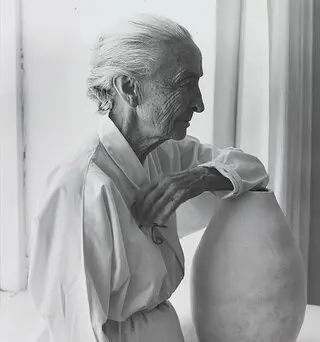
photo by: Laura Gilpin/Georgia O’Keeffe Museum.
Georgia O'Keeffe with pot. 1953.
Woodrow Wilson House (Washington, D.C.)
The Woodrow Wilson House is a National Trust Historic Site.
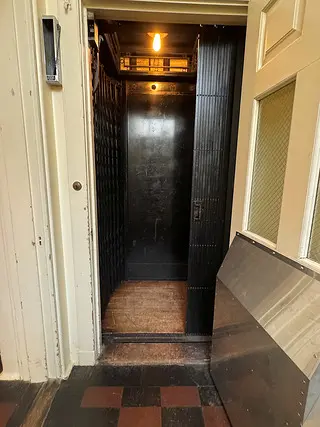
photo by: Woodrow Wilson House
Elevator at the Woodrow Wilson House
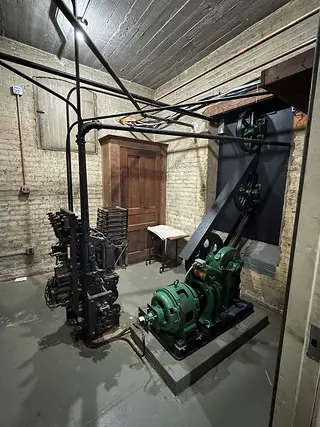
photo by: Woodrow Wilson House
View of the mechanical room for the elevator at the Woodrow Wilson House.
In October 1919, President Woodrow Wilson suffered a severe stroke that left him partially paralyzed on his left side and significantly impaired his mobility. This life-altering event occurred during the final year of his presidency and resulted in a lasting physical disability that shaped his remaining years. When Wilson and his wife, Edith, moved into their home on S Street, NW in Washington, D.C. after leaving the White House in 1921, accommodations were necessary to support his condition.
Among the most notable modifications was the installation of an elevator in an older trunk shaft—an uncommon residential feature at the time. The elevator allowed Wilson to navigate between floors without relying on stairs, preserving some measure of independence despite his disability. He used the elevator daily until his death in February 1924. This unique architectural feature remains a powerful symbol of how Wilson’s stroke not only altered his life, but also his home.
Couse-Sharp Historic Site (Taos, New Mexico)
The Couse-Sharp Historic Site is a member of HAHS.
Couse-Sharp Historic Site preserves and interprets the two studios of artist Joseph Henry Sharp. As the creative spaces of a deaf painter, they are an invaluable piece of disability history. When he was around 12 years old, Sharp nearly drowned while swimming in a river near his home. His life was thankfully saved, but he was left with a serious ear infection that led to partial, then complete hearing loss by age 14.
Sharp learned to read lips and built a habit of carrying a writing pad with him to help communicate. Sharp studied art in Cincinnati before continuing his training in Europe. He often painted Native Americans and was rumored to be a favored artist amongst Native models due to his quietness while painting. Sharp was a founder of the renowned Taos Society of Artists in 1915, whose works defined the global reputation of the American Southwest.
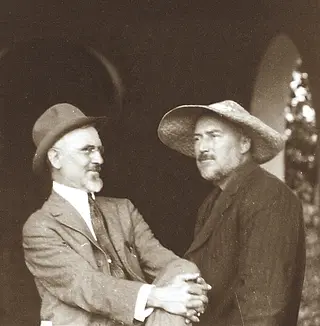
photo by: Couse-Sharp Historic Site
Joseph Henry Sharp (left) and Eanger Irving Couse (right) on the portal of The Couse House.
Albin Polasek Museum (Winter Park, Florida)
The Albin Polasek Museum is a member of HAHS.
Recognized as a leading American sculptor of the 20th century, Czech-born Albin Polasek served 30 years as head of the sculpture department at the Art Institute of Chicago before retiring to Winter Park, Florida in 1949.
After his arrival, Polasek experienced a stroke that resulted in paralysis on his left side. Now using a wheelchair, he adapted to painting with patience and determination, drawing and (with assistance) sculpting with his right hand only.
After his stroke, he produced over a dozen significant sculptures, including Victory of Moral Law, Emily Fountain, Man Reaching for the Moon, and the monumental Man Carving His Own Destiny. To create this masterpiece, Polasek held the chisel in his functional right hand and meticulously directed Robert A. Baille, a stone carver from Mount Rushmore, on where to strike the chisel with the hammer for each blow.
This sculpture, positioned at the entrance of the museum, is a testament to the dedication and perseverance of Albin Polasek.
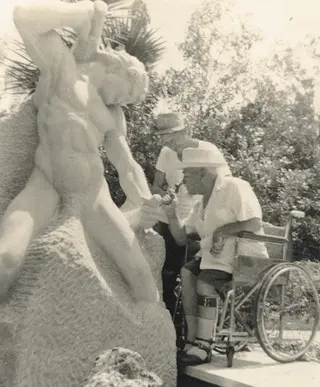
photo by: Albin Polasek Museum
Albin Polasek working with Robert A. Baillie, c. 1961.
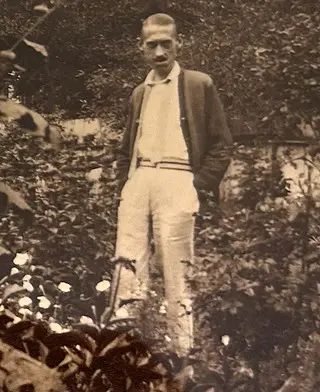
photo by: Demuth Museum
Charles Demuth during starvation treatment in Morristown, New Jersey, 1922.
Demuth Museum (Lancaster, Pennsylvania)
The Demuth Museum is a member of HAHS.
Charles Demuth fell seriously ill and began to experience the symptoms of diabetes in 1920. At the recommendation of art collector Dr. Albert C. Barnes, Demuth had his first consultation at a hospital in Morristown, New Jersey in February 1921. Though he tried to minimize diabetes’ effects on his life, the disease impacted his ability to travel, paint, and socialize.
In April 1922, Demuth entered Morristown under the care of Dr. Frederick Allen, who was known for his innovative treatment of diabetes. Demuth’s first treatment consisted of a starvation diet with just 500 calories per day. This method helped stabilize his blood sugar, but was not a long-term solution. Though insulin was newly available, discovered in 1921, Demuth resisted for a year, receiving his first insulin injection in April 1923. The drug’s effect was almost immediate, and Demuth resumed painting until eventually dying of complications from diabetes in 1935.
James Castle House (Boise, Idaho)
The James Castle House is a member of HAHS.
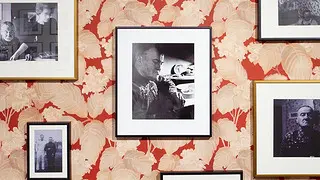
photo by: James Castle House
Portrait of James Castle installed as part of the Historic Artists’ Homes and Studios traveling exhibition.
The James Castle House is a historic site and museum serving as a testimony to the legacy of self-taught artist James Castle.
Born in 1899, James Castle created thousands of artworks during his lifetime, the majority of which were made while he lived in the House, Shed, and Trailer in Boise, Idaho.
Castle was born deaf, and, while he attended the Idaho School for Deaf and Blind, he never became proficient in reading, writing, or a conventional means of communication. As a deaf man and a self-taught artist, he was afforded the rare opportunity to focus on a daily artmaking practice while he lived with his family.
Through its preserved architecture, exhibitions, and artist-in-residence program, the James Castle House offers meaningful insight into Castle’s art, life, and d/Deaf experience.
Kykuit at The Pocantico Center (Tarrytown, New York)
Kykuit is a National Trust Historic Site.
Completed in 1913 for American businessman and philanthropist John D. Rockefeller, Kykuit has been home to four generations of the Rockefeller family, including Nelson Rockefeller, four-time governor of New York and vice president under President Gerald Ford.
Nelson Rockefeller had undiagnosed dyslexia and struggled with reading throughout his life. In a 1975 PBS special, “The Puzzle Children,” he outlines the strategies he developed during his career to successfully deliver speeches:
“If it helps a dyslexic to know I went through the same thing…
-But can conduct press conferences today in three languages…
-And can read a speech on television
- (Though I may have to rehearse it six times…
- With my script in large type…
- And my sentences broken into segments like these…
- And long words broken into syllables)…
- And win Congressional confirmation as Vice President of the United States…

photo by: Andy Warhol/Andy Romer
Andy Warhol, Portrait of Nelson A. Rockefeller #2 (1967), acrylic and silkscreen enamel on canvas. Photo by Andy Romer, 2017.
Then I hope the telling of my story as a dyslexic child could be an inspiration to the ‘puzzle children’ – for that is what I really care about.”
Donate Today to Help Save the Places Where Our History Happened.
Donate to the National Trust for Historic Preservation today and you'll help preserve places that tell our stories, reflect our culture, and shape our shared American experience.



